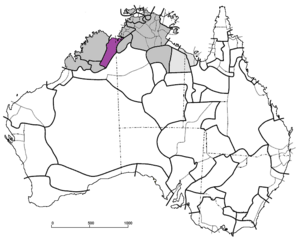Jarrakan languages facts for kids
Quick facts for kids Jarrakan |
|
|---|---|
| Djeragan | |
| Geographic distribution: |
from Halls Creek to Wyndham and Kununurra along the Ord River in the eastern Kimberley region |
| Linguistic classification: | One of the world's primary language families |
| Subdivisions: |
Miriwoongic
|
 Jarrakan languages (purple), among other non-Pama-Nyungan languages (grey)
|
|
The Jarrakan languages are a small group of languages spoken by Australian Aboriginal people in northern Australia. These languages are found in the eastern Kimberley region. They stretch from Halls Creek to Wyndham and Kununurra, following the Ord River. The name "Jarrakan" comes from the word jarrak. This word means "language" in the Kija language.
Contents
Main Jarrakan Languages
The Jarrakan language family includes three main languages. These are Kija, Miriwoong, and Gajirrawoong.
Kija Language
The Kija language is spoken by about 160 people. It forms its own group within the Jarrakan family, called Kijic.
Miriwoongic Languages
The Miriwoongic group includes two languages:
- Miriwoong: About 150 people speak this language.
- Gajirrawoong: Only a few people (three or four) speak this language.
Some experts, like Dixon (2002), believe that Miriwoong and Gajirrawoong are actually two dialects of the same language.
Doolboong Language
The Doolboong language might have also been a Jarrakan language. However, we are not sure because it is now extinct. This means no one speaks it anymore, and there are very few records of it.
Jarrakan Vocabulary
In 1940, a researcher named Arthur Capell wrote down some basic words from these languages. This helps us see how similar or different they are.
| English | Gidja | Guluwarin | Miriwun | Gadjerong |
|---|---|---|---|---|
| man | djiːlin | djiɣilin | djawalaŋ | djɔːmaŋ |
| woman | ŋaːlil | ŋaːlil | gawilaŋ | gabilaŋ |
| head | guŋgulïn | dumun | gaminduŋ | guɽunjuŋ |
| eye | muːlu | mɔːla | mɔːl | moːl |
| nose | manil | njiganïn | njumbur | njumbur |
| mouth | ḏuwundïn | ḏuwundïn | ḏalala | ḏabandaṉ |
| tongue | ḏalalan | ḏalalan | ḏalala | ḏalalaŋ |
| stomach | djaːm | daɽwun | galdjän | raːriːŋ |
| bone | gwïdji | daːlïn | jaːriŋ | jaːriŋ |
| blood | gjauəlïn | gjauldji | garŋan | guŋulu |
| kangaroo | djiːriṉ | djiriṉ | djiːriŋ | djiːriŋ |
| opossum | laŋguṉ | naŋguṉ | guman | guman |
| emu | wanjäbal | madjugul | madjuguŋ | |
| crow | waŋgaɳa | wɔŋgaral | waŋgariŋ | waŋgadiŋ |
| fly | buɳul | wurŋäl | ŋurin | ŋurin |
| sun | baːndil | baːndil | gaŋiriṉ | baːndiṉ |
| moon | gaɳgiṉ | gaɳgiṉ | gangiŋ | gaɳgiŋ |
| fire | maɳiṉ | gidjauəlïn | gadjaːwilaŋ | maːnuŋ |
| smoke | wangiṉ | dulubgari | ḏuŋgi | ḏuŋgiṉ |
| water | guːɭiṉ | goːliṉ | gäluŋ | gaːbuŋ |
See also
 In Spanish: Lenguas jarrakanas para niños
In Spanish: Lenguas jarrakanas para niños

